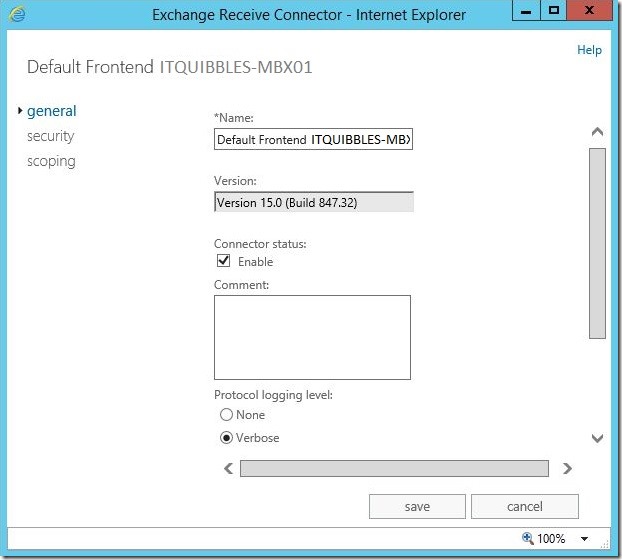Diagnostic Logging Exchange 2013
Thanks Microsoft for removing the useful Diagnostic logging from the Exchange Management Console once in Exchange 2010.
So now you need to increase the diagnostic levels through Powershell, which is fine if you know the commands and what you actually want to increase the levels of, again some (quite a lot) of these have changed from Exchange 2010)
First off, you can get a list of all the Diagnostic levels you’ll need by typing in Get-EventLogLevel in Powershell. This will give you the list below:
MSExchange Antispam\General
MSExchange Assistants\Assistants
MSExchange Autodiscover\Core
MSExchange Autodiscover\Web
MSExchange Autodiscover\Provider
MSExchange Availability\Availability Service
MSExchange Availability\Availability Service General
MSExchange Availability\Availability Service Authentication
MSExchange Availability\Availability Service Authorization
MSExchange Cluster\Move
MSExchange Cluster\Upgrade
MSExchange Cluster\Action
MSExchange Common\General
MSExchange Common\Configuration
MSExchange Common\Logging
MSExchange RBAC\General
MSExchange RBAC\RBAC
MSExchange CmdletLogs\General
MSExchange Configuration Cmdlet – Management Console\General
MSExchange Configuration Cmdlet – Management Console\RBAC
MSExchange Delegated Authentication Module\General
MSExchange LiveId Redirection Module\General
MSExchange Organization Redirection Module\General
MSExchange Certificate Authentication Module\General
MSExchange Control Panel\General
MSExchange Control Panel\Performance
MSExchange Control Panel\Redirect
MSExchange Control Panel\Proxy
MSExchange Extensibility\Transport Address Book
MSExchange Extensibility\MExRuntime
MSExchange EdgeSync\Synchronization
MSExchange EdgeSync\Topology
MSExchange EdgeSync\SyncNow
MSExchange TransportService\TransportService
MSExchange Web Services\Core
MSExchange IMAP4\General
MSExchange IMAP4 BE\General
MSExchange Messaging Policies\Journaling
MSExchange Messaging Policies\AttachFilter
MSExchange Messaging Policies\AddressRewrite
MSExchange Messaging Policies\Rules
MSExchange Messaging Policies\Prelicensing
MSExchange Messaging Policies\PolicyApplication
MSExchange Messaging Policies\JournalReportDecryption
MSExchange Messaging Policies\RightsManagement
MSExchange Messaging Policies\TransportDecryption
MSExchange Messaging Policies\RedirectionAgent
MSExchange Messaging Policies\Information Rights Management
MSExchange Anti-spam Update\HygieneUpdate
MSExchange Mailbox Replication\Service
MSExchange Mailbox Replication\Mailbox Move
MSExchange Mid-Tier Storage\Xtc
MSExchange Mid-Tier Storage\Audit
MSExchange Mid-Tier Storage\Discovery
MSExchange Mid-Tier Storage\Information Rights Management
MSExchange Mid-Tier Storage\CopyOnWrite
MSExchange Mid-Tier Storage\ResourceHealth
MSExchange Management Application\Shell
MSExchange Management Application\Console
MSExchange Management Application\ProvisioningAgent
MSExchange Management Application\ComponentInfoBasedTask
MSExchange Management Application\AdminAuditLog
MSExchange OWA\FormsRegistry
MSExchange OWA\Core
MSExchange OWA\Configuration
MSExchange OWA\Themes
MSExchange OWA\SmallIcons
MSExchange OWA\Proxy
MSExchange OWA\Transcoding
MSExchange OWA\ADNotifications
MSExchange OWA\InstantMessage
MSExchange POP3\General
MSExchange POP3 BE\General
MSExchange Process Manager\ProcessManager
MSExchange Repl\Service
MSExchange Repl\Exchange VSS Writer
MSExchange ReportingWebService\General
MSExchange Topology\Topology Discovery
MSExchange Unified Messaging\UMWorkerProcess
MSExchange Unified Messaging\UMCore
MSExchange Unified Messaging\UMManagement
MSExchange Unified Messaging\UMService
MSExchange Unified Messaging\UMClientAccess
MSExchange Unified Messaging\UMCallData
MSExchange Unified Messaging\MWI General
MSExchange Unified Messaging\UMCallRouter
MSExchange ADAccess\General
MSExchange ADAccess\Cache
MSExchange ADAccess\Topology
MSExchange ADAccess\Configuration
MSExchange ADAccess\LDAP
MSExchange ADAccess\Validation
MSExchange ADAccess\Recipient Update Service
MSExchange ADAccess\Site Update
MSExchange ADAccess\Exchange Topology
MSExchange ADAccess\MSERV
MSExchange ADAccess\GLS
MSExchangeADTopology\General
MSExchangeADTopology\Configuration
MSExchangeADTopology\Topology
MSExchangeApplicationLogic\TextMessaging
MSExchangeApplicationLogic\ServerPicker
MSExchangeIS\General
MSExchangeIS\Physical Access
MSExchangeIS\Logical Data Model
MSExchangeIS\Directory Services
MSExchangeIS\MAPI
MSExchangeIS\High Availability
MSExchangeMailboxAssistants\Service
MSExchangeMailboxAssistants\OOF Assistant
MSExchangeMailboxAssistants\OOF Library
MSExchangeMailboxAssistants\Resource Booking Attendant
MSExchangeMailboxAssistants\Email_Lifecycle_Assistant
MSExchangeMailboxAssistants\Junk Email Options Assistant
MSExchangeMailboxAssistants\Conversations Assistant
MSExchangeMailboxAssistants\Approval Assistant
MSExchangeMailboxAssistants\ELC Library
MSExchangeTransport\SmtpReceive
MSExchangeTransport\SmtpSend
MSExchangeTransport\DSN
MSExchangeTransport\Routing
MSExchangeTransport\Logging
MSExchangeTransport\Components
MSExchangeTransport\RemoteDelivery
MSExchangeTransport\Pickup
MSExchangeTransport\Categorizer
MSExchangeTransport\PoisonMessage
MSExchangeTransport\MessageSecurity
MSExchangeTransport\TransportService
MSExchangeTransport\Exch50
MSExchangeTransport\Process
MSExchangeTransport\ResourceManager
MSExchangeTransport\Configuration
MSExchangeTransport\Storage
MSExchangeTransport\Agents
MSExchangeTransport\Transport Address Book
MSExchangeTransport\Orar
MSExchangeTransport\Unused
MSExchangeTransport\ShadowRedundancy
MSExchangeTransport\Approval
MSExchangeTransport\TransportSafetyNet
MSExchangeTransport\TransportTenantAttribution
MSExchangeTransportSyncCommon\General
MSExchangeTransportSyncManager\General
MSExchangeTransportSyncWorker\General
MSExchangeTransportSyncWorkerFramework\General
MSExchange OutlookProtectionRules\Outlook Protection Rules
MSExchange Provisioning MailboxAssistant\Provisioning Assistant General
MSExchangeThrottling\General
MSExchangeThrottlingClient\General
MSExchange FailFast Module\General
MSExchange Store Driver Delivery\MSExchangeStoreDriverDelivery
MSExchange Store Driver Delivery\MeetingMessageProcessing
MSExchange Store Driver Delivery\OofHistory
MSExchange Store Driver Delivery\Approval
MSExchange Store Driver Delivery\UnifiedMessaging
MSExchange Store Driver Submission\MSExchangeStoreDriverSubmission
MSExchangeSubmission\MSExchangeSubmission
MSExchange Antimalware\General
MSExchange Antimalware\Init
MSExchange Antimalware\ScanResults
MSExchange Antimalware\ScanError
MSExchange OAuth\Requests
MSExchange OAuth\Configuration
MSExchange OAuth\Server
MSExchange BackEndRehydration\Requests
MSExchange BackEndRehydration\Configuration
MSExchange BackEndRehydration\Server
MSExchange Front End HTTP Proxy\Core
MSExchange RemotePowershell BackendCmdletProxy Module\General
MSExchange Error Logging Module\General
MSExchange Client Diagnostics Module\General
MSExchangeFrontEndTransport\SmtpReceive
MSExchangeFrontEndTransport\SmtpSend
MSExchangeFrontEndTransport\DSN
MSExchangeFrontEndTransport\Routing
MSExchangeFrontEndTransport\Logging
MSExchangeFrontEndTransport\Components
MSExchangeFrontEndTransport\RemoteDelivery
MSExchangeFrontEndTransport\Pickup
MSExchangeFrontEndTransport\Categorizer
MSExchangeFrontEndTransport\PoisonMessage
MSExchangeFrontEndTransport\MessageSecurity
MSExchangeFrontEndTransport\TransportService
MSExchangeFrontEndTransport\Exch50
MSExchangeFrontEndTransport\Process
MSExchangeFrontEndTransport\ResourceManager
MSExchangeFrontEndTransport\Configuration
MSExchangeFrontEndTransport\Storage
MSExchangeFrontEndTransport\Agents
MSExchangeFrontEndTransport\Transport Address Book
MSExchangeFrontEndTransport\Orar
MSExchangeFrontEndTransport\Unused
MSExchangeFrontEndTransport\ShadowRedundancy
MSExchangeFrontEndTransport\Approval
MSExchangeFrontEndTransport\TransportSafetyNet
MSExchangeFrontEndTransport\TransportTenantAttribution
To change these levels, in Powershell type the following: (I’ve used MSExchangeTransport\Smtpsend as an example)
Set-EventLogLevel -Identity exchangeserver\MSExchangeTransport\Smtpsend -level expert

At the end of the command the levels can be set to the following depending on your needs:
Lowest, Low, Medium, High, Expert
Just so you know, another place which may help logging is on the Receive Connectors. Open the Exchange Admin Center, on the left Click on Mail Flow and double click the Receive connector you want to change the logging of: (The only options are “None” or “Verbose”)

Here you can change the Protocol Logging Level.
So there you go, now you can check the Eventvwr and find out where the problem lies.
Hope this gets you out of a sticky quibble.

Leave a Reply